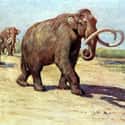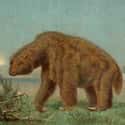-
(#1) Humans Stalked Giant Sloths By Stepping In The Mammals' Footprints
In a rare discovery of human footprints, paleontologists have discerned how our ancestors tracked giant sloths, called Megatherium and Megalonyx, through the White Sands desert. The unique information these prints provide gives remarkable insights into predator-prey interactions during the Pleistocene Epoch.
Human footprints are not likely to remain preserved over long periods of time but because these individuals walked within the larger prints left by the giant ground sloths they were hunting, over 25 prints were were preserved in fossil material. When humans were tracking, harassing, or hunting giant sloths, they appeared to have done so stealthily, staying in the exact same tracks as the large mammals they trailed.
-

(#2) Humans May Have Teamed Up To Harass Giant Sloths
Based on the layout of the giant sloth and human footprints, it appears as though there was teamwork involved in the exercise. Researchers theorize that a face-to-face match with a giant sloth was best won by incorporating an element of surprise. Dr. Matthew Bennett speculates, “While [the sloth] was being distracted and turning, somebody else would come across and try and deliver the killer blow. It’s an interesting story, and it’s all written in the footprints.”
There's evidence that sloths moved in zig-zag patterns, indicating evasion tactics. It's difficult to tell if humans pursued more than one sloth at a time, however.
-

(#3) Sloth Track Marks Indicate Defensive, Bipedal Positions
In addition to the footprints of the giant sloths and humans, there are track marks that indicate the sloths walked bent over, dragging their knuckles along the ground. When they were under threat, however, they stood erect. According to the layout of the sloth prints, the mammals turned to face their hunter, standing tall on their hind legs. Moving their arms in what researchers call "flailing circles," giant sloths used their front limbs to protect themselves.
-

(#4) Sloth Footprints Reveal The Mammals Had Wolverine-Like Claws
The "elongated kidney-shaped tracks and claw marks" left by giant sloths reveal how strong and lethal their limbs could be. Like modern sloths, although much larger, the giant sloths had blunt faces, strong jaws, large teeth, and three claws on their forelimbs. Their long arms and sharp claws gave them a deadly reach when confronted.
-

(#5) Sloths Were Herbivores But Their Claws Could Destroy A Human With Relative Ease
Giant sloths were faster than sloths today and weighed anywhere between 8,000 to 10,000 pounds. Giant sloths, like their modern counterparts, were herbivores, so they weren't interested in hunting humans. Their long arms made it easy for them to grab large amounts of vegetation from tall trees. The strength they had would have also been useful when confronted by a predator. Giant sloths, which were 10 feet tall or more, protected themselves by rising onto their hind legs and swinging their arms, which could cause a lot of damage. Dr. Matthew Bennett, professor of environmental and geographical sciences at Bournemouth University in southern England pointed out that in "going head-to-head with a giant sloth, chances are you might come off badly."
-
(#6) Ancient Sloths Were Just One Of Several Gigantic, Dangerous Creatures In The White Sands Desert
Giant sloths of the Megatherium and Megalonyx varieties were not the only massive prehistoric animals in the White Sands desert. Scientists have discovered tracks that indicate the presence of mammoths, as well as giant camel-like animals. Mammoths were often 14 feet tall at the shoulder and weighed approximately 20,000 pounds, not counting their large tusks. The ancient camels were most likely one-humped and stood about seven feet tall.
Other animals present in North America during the Pleistocene Epoch included 500-pound American lions, quick and powerful dire wolves, and ferocious saber-toothed cats.
-
(#7) Humans May Have Played A Role In The Extinction Of Giant Sloths
Giant sloths like the ones harassed or hunted by humans in the White Sands desert went extinct about 11,700 years ago, near the end of the Pleistocene Epoch. With their footprint finds, scientists are exploring the idea that humans were influential in their extinction. Climate change is known to be a contributing factor in the demise of giant sloths, but scientists say that "predation (successful or not) may have contributed to the sloth’s extinction in North America."
-

(#8) It's Unclear Exactly Why Humans Tracked And Hunted Sloths
Scientists still aren't sure why humans hunted sloths—there's no evidence that humans actually ate the animals, since there were no tool makings on their remains. However, sloths had so much muscle that removing their meat wouldn't require hunters to touch the bone, and therefore wouldn't leave any evidence.
Other theories abound. Paleontologist Andrew R.C. Milner says, "Maybe ground sloths were fun to harass? Who knows.” Other researchers think humans were trying to kill the giant sloths "because a big kill could fill many stomachs without waste, or maybe it was pure human bravado."
-

(#9) The Giant Sloth Is Still A Legendary Creature In South America
Sightings of the mapinguari in Brazil and other parts of the Amazon basin keeps legend of the long-extinct giant sloth alive and well. An sloth-ish creature, the mapinguari is thought to still exist in the jungles and caves of South America. People claim to have found its skin, feces, and footprints in addition to spotting it the creature itself.
During the 1990s, David C. Oren, ornithologist and expert on Amazonian biodiversity, sought out the mapinguari after hearing multiple sightings. He believed that the prehistoric creature was hiding in the dense rainforest, something Argentinean paleontologist Florentino Ameghino posited during the late 1800s. Oren never found a mapinguari, and many of his colleagues think that he's a "kook," but theories about the creature's existence remain prevalent in South American folklore.
-
(#10) Thousands Of Tracks Have Been Preserved At White Sands
Given its remote location and proximity to military land, the White Sands desert has been so isolated that a large amount of prehistoric and ancient material has been preserved. As a result, scientists have been discovering footprints and trackways in the White Sands desert for almost a century. In 1932, government tracker Ellis Wright thought he found tracks from a large, prehistoric human. In 1981, however, they were identified as those of mammoths, camels, and an unidentified mammal. In 2001, scientists examined tracks at the White Sands Military Range and found "[25] mammoth tracks and 64 camel footprints." In 2007, and again in 2011, hundreds more tracks were discovered, many of which indicated interactions between prehistoric humans and mammals.
With the help of aerial photography and satellite imagery, researchers have been able to get a better look at the trackways and their paths. Technological innovations have also preserved and protected the discoveries at White Sands, especially as weather and human interference threaten the tracks. With the fragility of the tracks in mind, new technology allows the tracks "to be studied long after they have weathered away and [to] enable the creation of exact 3D replica models for future generations to enjoy and study."
New Random Displays Display All By Ranking
About This Tool
The bones of giant sloths were buried in Campo Laborde, until 2000, when a local farmer discovered them. Scientists have re-analyzed these fossils and more accurately determine the time of this fossil. The ground sloth eaten existed in ancient times can reach up to 3 meters in height and weigh more than 4 tons. The fossil discovered by Campo Laborde is the only confirmed ground sloth in history.
The giant ground sloth went extinct at the end of the Late Pleistocene about 12,000 years ago. You could find 10 details about the history of giant ground sloth in this random tool.
Our data comes from Ranker, If you want to participate in the ranking of items displayed on this page, please click here.














